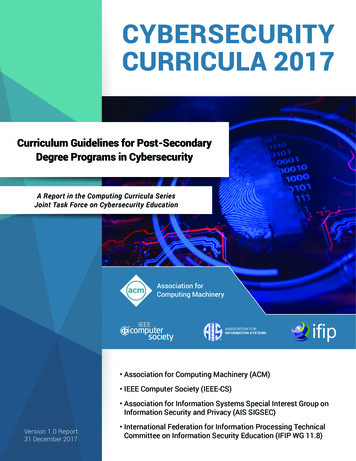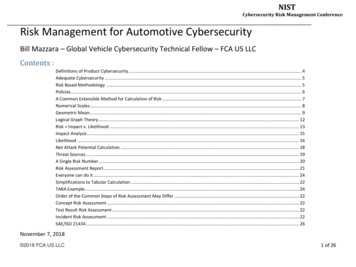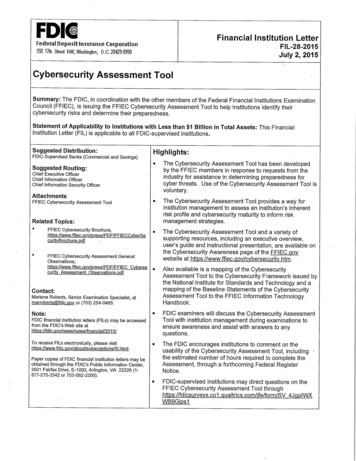
Transcription
CYBERSECURITYCURRICULA 2017Curriculum Guidelines for Post-SecondaryDegree Programs in CybersecurityA Report in the Computing Curricula SeriesJoint Task Force on Cybersecurity EducationAssociation forComputing MachineryASSOCIATION FORINFORMATION SYSTEMSifip Association for Computing Machinery (ACM) IEEE Computer Society (IEEE-CS) Association for Information Systems Special Interest Group on Information Security and Privacy (AIS SIGSEC)Version 1.0 Report31 December 2017 International Federation for Information Processing Technical Committee on Information Security Education (IFIP WG 11.8)
CybersecurityCurricula 2017Curriculum Guidelines forPost-Secondary Degree Programsin CybersecurityA Report in the Computing Curricula SeriesJoint Task Force on Cybersecurity EducationAssociation for Computing Machinery (ACM)IEEE Computer Society (IEEE-CS)Association for Information Systems Special Interest Group on InformationSecurity and Privacy (AIS SIGSEC)International Federation for Information Processing Technical Committee onInformation Security Education (IFIP WG 11.8)Version 1.0 Report31 December 20171
Cybersecurity 2017CSEC2017Version 1.0 Report31 December 2017Copyright 2017 by ACM, IEEE, AIS, IFIPALL RIGHTS RESERVEDCopyright and Reprint Permissions: Permission is granted to use these curricular guidelines for thedevelopment of educational materials and programs. Other use requires specific permission. Permissionrequests should be addressed to: ACM Permissions Dept. at permissions@acm.org, the IEEE CopyrightsManager at copyrights@ieee.org, the AIS eLibrary@aisnet.org or the IFIP at ifip@ifip.org.ISBN: 978-1-4503-5278-9DOI: 10.1145/3184594Web link: https://dl.acm.org/citation.cfm?id 3184594When available, you may order additional copies from:ACM Order DepartmentP.O. Box 30777New York, NY 10087-0777IEEE Computer SocietyCustomer Service Center10662 Los VaquerosP.O. Box 3014Los Alamitos, CA 90720-1314Sponsors:This report was made possible by financial support from the following:Association for Computing Machinery (ACM)IEEE Computer Society (IEEE-CS)Association for Information Systems Special Interest Group on Information Security and Privacy(AIS SIGSEC)U.S. National Science Foundation (Award# 1623104)Intel CorporationU.S. National Security Agency (Grant# H98230-17-1-0219)The CSEC2017 Final Report has been endorsed by ACM, IEEE-CS, AIS SIGSEC, and IFIP WG 11.8.Cover designed by Nelly Group, LLC.2
Cybersecurity 2017CSEC2017Version 1.0 Report31 December 2017CybersecurityCurricula 2017Version 1.0 Report31 December 2017A Report in the Computing Curricula SeriesJoint Task Force on Cybersecurity EducationAssociation for Computing Machinery (ACM)IEEE Computer Society (IEEE-CS)Association for Information Systems Special Interest Group on InformationSecurity and Privacy (AIS SIGSEC)International Federation for Information Processing Technical Committee onInformation Security Education (IFIP WG 11.8)3
Cybersecurity 2017CSEC2017Version 1.0 Report31 December 2017CSEC2017 Joint Task ForceDiana L. Burley, Ph.D. (JTF Co-Chair, ACM)Professor, Human & Organizational LearningExecutive Director, Institute for Information Infrastructure ProtectionThe George Washington University, USAMatt Bishop, Ph.D. (JTF Co-Chair, ACM/IFIP)Professor, Computer ScienceCo-Director, Computer Security LaboratoryUniversity of California, Davis, USAScott Buck (ACM)University Program DirectorIntel Labs, Intel, USAJoseph J. Ekstrom, Ph.D. (IEEE CS)Associate Professor Emeritus, Information TechnologyBrigham Young University, USALynn Futcher, Ph.D. (ACM/IFIP)Associate ProfessorNelson Mandela University, South AfricaDavid Gibson, Ph.D. (ACM)Professor Emeritus, Computer ScienceDepartment of Computer and Cyber ScienceUnited States Air Force Academy, USAElizabeth K. Hawthorne, Ph.D. (ACM)Senior Professor, Computer Science and CybersecurityUnion County College, USASiddharth Kaza, Ph.D. (ACM)Associate Professor, Computer & Information SciencesChair, Department of Computer & Information SciencesTowson University, USAYair Levy, Ph.D. (AIS SIGSEC)Professor, Information Systems and CybersecurityDirector, Center for Information Protection, Education, and Research (CIPhER)Nova Southeastern University, USAHerbert Mattord, Ph.D. (AIS SIGSEC)Associate Professor, Information SystemsDirector of Education, Institute for Cybersecurity Workforce DevelopmentKennesaw State University, USAAllen Parrish, Ph.D. (IEEE CS)Professor, Cyber ScienceChair, Department of Cyber ScienceUnited States Naval Academy, USA4
Cybersecurity 2017CSEC2017Version 1.0 Report31 December 2017Table of ContentsChapter 1: Introduction to Cybersecurity Education1.1 The Joint Task Force991.1.1 The Vision101.1.2 The Mission101.1.3 The Goals111.2 The Audience111.3 Sources121.4 Global Community Engagement121.4.1 International Workshops131.4.2 Global Stakeholder Survey131.4.3 Contributor Acknowledgement141.5 Cybersecurity as a Discipline141.6 Report Structure15Chapter 2: The Cybersecurity Discipline162.1 The Rise of Cyberthreats162.2 The Emergence of Cybersecurity as a Discipline172.3 Characteristics of a Cybersecurity Program18Chapter 3: Cybersecurity Curricular Framework193.1 Philosophy and Approach193.2 Thought Model193.2.1 Knowledge Areas203.2.2 Crosscutting Concepts213.2.3 Disciplinary Lens22Chapter 4: Content of the Cybersecurity Curricular Framework4.1 Knowledge Area: Data Security23244.1.1 Knowledge Units and Topics244.1.2 Essentials and Learning Outcomes304.2 Knowledge Area: Software Security314.2.1 Knowledge Units and Topics314.2.2 Essentials and Learning Outcomes364.3 Knowledge Area: Component Security374.3.1 Knowledge Units and Topics374.3.2 Essentials and Learning Outcomes395
Cybersecurity 2017CSEC2017Version 1.0 Report31 December 20174.4 Knowledge Area: Connection Security404.4.1 Knowledge Units and Topics404.4.2 Essentials and Learning Outcomes464.5 Knowledge Area: System Security474.5.1 Knowledge Units and Topics474.5.2 Essentials and Learning Outcomes514.6 Knowledge Area: Human Security524.6.1 Knowledge Units and Topics524.6.2 Essentials and Learning Outcomes584.7 Knowledge Area: Organizational Security594.7.1 Knowledge Units and Topics594.7.2 Essentials and Learning Outcomes694.8 Knowledge Area: Societal Security704.8.1 Knowledge Units and Topics704.8.2 Essentials and Learning Outcomes76Chapter 5: Industry Perspectives on Cybersecurity785.1 The Technical – Business Skills Continuum785.2 Career Focus795.3 Linking Cybersecurity Curriculum to Professional Practice805.3.1 Application Areas805.3.2 Training and Certifications825.4 Workforce Frameworks825.4.1 NCWF Implementation Roadmaps825.4.2 Overview845.4.3 Relevant Courses845.4.4 KSA Acquisition Strategies845.4.5 Challenges85References86Appendix A: Contributors89The Global Advisory Board To the Joint Task Force on Cybersecurity Education89The Industrial Advisory Board To the Joint Task Force on Cybersecurity Education 91Knowledge Area Working Groups93Knowledge Area: Data Security93Knowledge Area: Software Security946
Cybersecurity 2017CSEC2017Version 1.0 Report31 December 2017Knowledge Area: Component Security95Knowledge Area: Connection Security96Knowledge Area: System Security97Knowledge Area: Human Security98Knowledge Area: Organizational Security99Knowledge Area: Societal SecurityContributing Reviewers100101Appendix B: Essentials Table Overview111Appendix C: Exemplars112Curricular Exemplar Template112Workforce Exemplar Template116Course Exemplar Template1187
Cybersecurity 2017CSEC2017Version 1.0 Report31 December 2017Table of FiguresFigure 1.Global Engagement ActivitiesFigure 2.Structure of the Cybersecurity Discipline.Figure 3.CSEC Thought Model.Figure 4.Knowledge Area Structure.Figure 5.Linking the CSEC2017 Thought Model and Workforce Frameworks.Figure 6.Roadmap Components for Coursework.Figure 7.Contributing Reviewers by Country1218202183841018
Cybersecurity 2017CSEC2017Version 1.0 Report31 December 2017Chapter 1: Introduction to Cybersecurity EducationBy all accounts, the world faces a current and growing workforce shortage of qualifiedcybersecurity professionals and practitioners. In fact, both government and nongovernment sources project nearly 1.8 million cybersecurity-related positions goingunfilled by 2022 1. The workforce demand is acute, immediate, and growing 2. In order todevelop the required talent, academic departments across the spectrum of computingdisciplines are launching initiatives to establish new cybersecurity programs or courses ofstudy within existing programs. Whether developing full new programs, defining newconcentrations within existing programs, or augmenting existing course content, theseinstitutions need curricular guidance based on a comprehensive view of the cybersecurityfield, the specific demands of the base discipline, and the relationship between thecurriculum and cybersecurity workforce frameworks.In August 2015, the Association for Computing Machinery (ACM) Education Boardrecognized this urgent need and took measures to assemble a Joint Task Force onCybersecurity Education (CSEC2017) with other professional and scientific computingsocieties to develop comprehensive curricular guidance in cybersecurity education.For nearly five decades, starting with Computer Science 1968 3, the ACM educationinitiative has collaborated with other professional and scientific societies to establishcurricular guidelines for academic program development in the computing disciplines.Currently, ACM curricular volumes provide recommendations in computer science,computer engineering, information systems, information technology, and softwareengineering. The ACM Computing Curricula 2005 Report (CC2005), currently beingupdated, provides an overview of the curriculum guidelines for each of these fivecomputing disciplines 4. This volume, CSEC2017, represents an expansion of the ACMeducation initiative to include the first set of global curricular recommendations incybersecurity education.Due to the highly dynamic nature of cybersecurity, it is strongly recommended that thesecurricular guidelines be reviewed within five years of the publication date.1.1 The Joint Task ForceThe CSEC2017 Joint Task Force on Cybersecurity Education (JTF) was officiallylaunched in September 2015 as a collaboration between major international computingsocieties: Association for Computing Machinery (ACM), IEEE Computer Society(IEEE CS) 5, Association for Information Systems Special Interest Group on Information1See, for example, CSO Online: icate-severe-workforce-shortage.html2(ISC)2 Report available M Curriculum Committee on Computer Science. 1968. Curriculum 68: Recommendations forAcademic Programs in Computer Science. Comm. ACM 11, 3 (Mar. 1968), 151-197.4ACM Computing Disciplines Overview: 5IEEE CS website: https://www.computer.org/9
Cybersecurity 2017CSEC2017Version 1.0 Report31 December 2017Security and Privacy (AIS SIGSEC) 6, and International Federation for InformationProcessing Technical Committee on Information Security Education (IFIP WG 11.8) 7.The ACM Education Board appointed the CSEC2017 JTF co-chairs. In addition to theco-chairs, the CSEC2017 JTF includes nine leading cybersecurity professionals selectedby the participating professional societies to represent their constituencies and to providea diverse set of perspectives. The JTF members are listed along with their affiliations atthe beginning of this document.The CSEC2017 JTF is an outcome of the Cyber Education Project (CEP) 8. The CEPinitiative was organized in July 2014 by a group of computing professionals whorepresented a diverse cross-section of academic institutions and professional societies.The CEP mission was two-fold: to initiate the processes for (1) developing undergraduatecurricular guidance; and (2) establishing a case for the accreditation of educationalprograms in the cyber sciences.The CSEC2017 JTF is advancing the first mission of the CEP:To develop comprehensive curricular guidance in cybersecurity education thatwill support future program development and associated educational efforts at thepost-secondary level.While the CSEC2017 JTF has chosen to use the more generally accepted termcybersecurity instead of the term cyber sciences advanced by the CEP8, conceptually theterms are consistent.1.1.1 The VisionThe CSEC2017 JTF has worked actively since its inception in September of 2015 todefine project parameters and establish a foundational vision, mission and goals. Theproject vision is:The CSEC2017 curricular volume will be the leading resource of comprehensivecybersecurity curricular content for global academic institutions seeking todevelop a broad range of cybersecurity offerings at the post-secondary level.1.1.2 The MissionThe CSEC2017 mission is twofold: To develop comprehensive and flexible curricular guidance in cybersecurityeducation that will support future program development and associatededucational efforts at the post-secondary level, and To produce a curricular volume that structures the cybersecurity discipline andprovides guidance to institutions seeking to develop or modify a broad range ofprograms, concentrations and/or courses rather than a prescriptive document tosupport a single program type.6AIS SIGSEC website: http://aisnet.org/group/SIGSECIFIP WG 11.8 website: https://www.ifiptc11.org/wg1188Cyber Education Project website: http://cybereducationproject.org/about/710
Cybersecurity 2017CSEC2017Version 1.0 Report31 December 20171.1.3 The GoalsBased on this mission, the CSEC2017 JTF established the following goals for thecurricular volume: To describe a vision of proficiency in cybersecurity, To define a structure for the cybersecurity discipline by developing a thoughtmodel that defines the boundaries of the discipline and outlines key dimensions ofthe curricular structure, To support the alignment of academic programs with industry needs incybersecurity, To involve broad global audience of stakeholders through continuous communityengagement during the development process, To develop curricular guidance that is comprehensive enough to support a widerange of program types, and To develop curricular guidance that is grounded in fundamental principles thatprovide stability, yet is structured to provide flexibility to support evolvingprogram needs.1.2 The AudienceThe CSEC2017 JTF defines the primary and secondary audiences for this cybersecurityguidance below.Primary audience: Faculty members in computing-based disciplines at academic institutions aroundthe world who are interested in developing cybersecurity programs, defining newcybersecurity concentrations within existing programs, or augmenting existingprograms (including existing concentrations and courses) to incorporatecybersecurity content.Secondary audience: Industry members who will assist with cybersecurity program development withinacademic institutions, develop industry-based programs, and be consumers of thestudent outcomes of these programs, Training and professional development providers, Faculty members in non-computing based disciplines who are developing orintend to develop allied programs that teach cybersecurity concepts and skills, Academic administrators with oversight for program and course development andrevision, Workforce framework developers (government and non-government), Policymakers, Members of the K-12 educational community who are preparing students to enterpost-secondary education in cybersecurity, and11
Cybersecurity 2017CSEC2017Version 1.0 Report31 December 2017 Other stakeholders involved with cybersecurity workforce developmentinitiatives.1.3 SourcesThe curricular guidelines developed in this document build upon prior work in computersecurity, information assurance and cyber security education, training, and workforcedevelopment. In addition to the sources listed later in this document under References,major sources used in the development of this document include: Computer Science Curricula 2013: Curriculum Guidelines for UndergraduateDegree Programs in Computer Science, Global IT Skills Framework for the Information Age (SFIA), Requirements of the U.S. National Security Agency and U.S. Department ofHomeland Security National Centers of Academic Excellence in Cyber Defenseand Cyber Operations, Information Technology Curricula 2017: Curriculum Guidelines forBaccalaureate Degree Programs in Information Technology, Guide to the Systems Engineering Body of Knowledge, and U.S. National Initiative for Cybersecurity Education (NICE) CybersecurityWorkforce Framework.1.4 Global Community EngagementFigure 1. Global engagement activities.The CSEC2017 JTF continuously engaged the broad stakeholder community throughoutthe development process. Community members provided input to shape the approach,content and organizational structure of the CSEC report. Community engagementactivities have included: special sessions, panels and workshops at conferences affiliated12
Cybersecurity 2017CSEC2017Version 1.0 Report31 December 2017with participating professional societies, international conferences, keynote addresses,webinars, working group meetings, government briefings, and advisory board briefings.As shown in Figure 1, community engagement activities were held in a variety oflocations around the world. These activities were positioned as regional conveningopportunities to gather insights from a cross-section of subject matter experts. Amongthese activities, key milestones in the development process included internationalworkshops and a global stakeholder survey.1.4.1 International WorkshopsIn 2016, with the support of the Intel Corporation and the U.S. National ScienceFoundation, the JTF organized and hosted the International Security Education Workshop(ISEW), which was held June 13-15, 2016, in Philadelphia, PA 9. The workshop wasstructured to advance the CSEC2017 development process. Through panel discussionsand working group sessions, approximately 75 stakeholders from the global cybersecurityeducation community provided input on the curricular content and structure by debatingtwo key questions: What should be included in a cybersecurity degree program? How should the volume of curricular recommendations be organized anddisseminated?The full meeting report is available on the CSEC2017 website. The input gathered fromparticipants of the ISEW informed the first version of the CSEC2017 thought model andserved as the basis of the global stakeholder survey.In August 2016, government representatives from 10 of the Association of South EastAsian Nations (ASEAN), along with leaders from Japan and Australia, participated in a2016 project briefing in Singapore. ASEAN representatives included: Brunei, Malaysia,Laos, Thailand, Singapore, Cambodia, Myanmar, Vietnam, Indonesia, and Philippines.Approximately one year following the ISEW, on May 29-31, 2017, the JTF organized acommunity engagement session at the 10th World Information Security EducationConference (WISE 10) in Rome, Italy. Participants from countries such as Germany,Norway, Russia Sweden, South Africa, and the United States gathered to discuss theCSEC2017 v. 0.05 draft document and to advance the development process. A report onthe workshop structure and purpose was published in the WISE 10 proceedings.1.4.2 Global Stakeholder SurveyIn September 2016, after a year of community engagement and developmental work, theJTF launched a global stakeholder survey to solicit feedback on the proposed curricularthought model. Stakeholders were invited to participate in the survey through directinvitations, announcements in public educational and scientific forums, social mediaoutreach via the JTF website and LinkedIn, and invitations sent through the distributionlists of participating professional associations. The survey yielded 231 responses from9The ISEW was co-located with the Colloquium for Information Systems Security Education (CISSE), andsponsored by the Intel Corporation, the National Science Foundation (NSF), and the Institute forInformation and Infrastructure Protection (I3P) at the George Washington University (GW).13
Cybersecurity 2017CSEC2017Version 1.0 Report31 December 2017stakeholders located in 20 countries; working across academia, industry and government;and representing all five computing disciplines.In summary, survey respondents suggested that the JTF clarify the intended audience ofthe curricular volume; refine the definitions and distinguish between the curricularelements of the thought model; provide additional information on the content of each ofthe knowledge categories; simplify the thought model; and adapt the structure to allowfor placement of emerging topics. The JTF used these comments to revise the thoughtmodel. The full survey report is available on the CSEC2017 website.1.4.3 Contributor AcknowledgementThe JTF gratefully acknowledges the valuable contributions of all participants in ourcommunity engagement efforts. We specifically recognize the global subject matterexperts who provide advice as members of our advisory boards and working groups.Throughout the development process, members of the Global Advisory Board andIndustry Advisory Board provided advice on the development process, global communityengagement strategies and specific curricular content. Members of our Knowledge AreaWorking Groups assisted task force members with the development of knowledge areacurricular content.We carefully considered all comments and critiques from community members, and weare particularly appreciative of the many comments provided as feedback. Acomprehensive list of contributors (including participants in the global workshops), alongwith a graphical depiction of the breadth of global participation, appears in Appendix Aat the end of this document. 101.5 Cybersecurity as a DisciplineIn the CC2005 Overview Report, the ACM identifies five primary computing disciplines,and recognizes a category of computing disciplines that highlights the increasing numberof hybrid or interdisciplinary courses of study. Computer Engineering, Computer Science, Information Systems, Information Technology, Software Engineering, Mixed Disciplinary Majors (xx Informatics or Computational xx).The CSEC2017 JTF advances cybersecurity as a new computing discipline and positionsthe cybersecurity curricular guidance within the context of the current set of definedcomputing disciplines. These five disciplines (listed above) often serve as the foundationof new cybersecurity programs (or courses of study). As a result, the disciplinary lensshapes the depth of coverage and the desired student learning outcomes. The manner in10While we tried to accurately capture all contributors, if we missed or misrepresented yourparticipation, please contact us for corrections.14
Cybersecurity 2017CSEC2017Version 1.0 Report31 December 2017which the disciplinary lenses shape the curricular content will be fully described inchapter 3 of this document.1.6 Report StructureThis report, CSEC2017 v.1.0, presents the work of the JTF. The CSEC2017 reportprovides an overview of the cybersecurity discipline to frame the curricular model. Thedocument then presents the curricular framework and outlines the recommendedcurricular content. Next, and in order to place the content within the larger context, thereport highlights industry perspectives on cybersecurity. Finally, to aid withimplementation, the report discusses issues related to the educational practice, suggests aprocess for developing roadmaps that link the curricular model to workforce frameworks,and references course, curricular and workforce exemplars that highlight how globalinstitutions could implement the curricular guidelines.The roadmaps and exemplars will be continuously received through the communityengagement website: http://cybered.acm.org (coming soon).15
Cybersecurity 2017CSEC2017Version 1.0 Report31 December 2017Chapter 2: The Cybersecurity DisciplineThe CSEC2017 JTF defines cybersecurity as:A computing-based discipline involving technology, people, information, andprocesses to enable assured operations in the context of adversaries. It involvesthe creation, operation, analysis, and testing of secure computer systems. It is aninterdisciplinary course of study, including aspects of law, policy, human factors,ethics, and risk management.Cybersecurity is a computing-based discipline involving technology, people, information,and processes to enable assured operations in the context of adversaries. It draws fromthe foundational fields of information security and information assurance; and began withmore narrowly focused field of computer security.The need for cybersecurity arose when the first mainframe computers were developed.Multiple levels of security were implemented to protect these devices and the missionsthey served. The growing need to maintain national security eventually led to morecomplex and technologically sophisticated security safeguards. During the early years,cybersecurity as practiced, even if not specifically identified as such, was astraightforward process composed predominantly of physical security and documentclassification. The primary threats to security were physical theft of equipment,espionage against products of the systems, and sabotage. As society’s reliance on broadcyber infrastructure has expanded, so too has the threat environment.2.1 The Rise of CyberthreatsAn agency of the U.S. Department of Defense, the Advanced Research Projects Agency(ARPA) was created in 1958 and began examining the feasibility of a redundant,networked communications system to support the exchange of computer data. Theresulting network, called ARPANET, was created in the late 1960s and saw wide use,increasing the potential for its misuse.Security that went beyond protecting the physical location of computing deviceseffectively began with a single paper published by the RAND Corporation in February1970 for the Department of Defense. That report, RAND Report R-609, attempted todefine the multiple controls and mechanisms necessary for the protection of acomputerized data-processing system.In the 1970s, the development of TCP (the Transmission Control Protocol) and IP (theInternet Protocol) led to the emergence of the Internet. The development of the WorldWide Web in the 1980s brought the Internet to wide use, which significantly increasedthe importance of cybersecurity. The U.S. Government passed several key pieces oflegislation that formalized the recognition of computer security as a critical issue forfederal information systems including the Computer Fraud and Abuse Act of 1986 andthe Computer Security Act of 1987. The Internet eventually brought ubiquitousconnectivity to virtually all computers, where integrity and confidentiality were a lowerpriority than the drive for availability. Many problems that plague the Internet todayresult from this early lack of focus on security awareness.16
Cybersecurity 2017CSEC2017Version 1.0 Report31 December 2017Early computing approaches relied on security that was built into the physicalenvironment of the data center that housed the computers. As networked computersbecame the dominant style of computing, the ability to physically secure a networkedcomputer was lost, and the stored information became more exposed to security threats.Larger organizations began integrating security into their computing strategies. Anti-virusproducts became extremely popular, and cybersecurity began to emerge as anindependent discipline.The Internet brings unsecured computer networks and billions of connected devices intocontinuous communication with each other. The security of each computer’s storedinformation is contingent upon awareness, learning, and applying cybersecurityprinciples. Securing a computer’s stored information can be accomplished by firstdetermining a value for the information. Choosing security controls to apply and protectthe information as it is transmitted, processed and stored should be commensurate withthat value and its threat environment.Recent years have seen a growing awareness of the need to improve cybersecurity, aswell as a realization that cybersecurity is important to the national defense of everycountry. The growing threat of cyberattacks has made governments and companies moreaware of the need to defend the computerized control systems of utilities and othercritical infrastructure. Another growing concern is the threat of nation-states engaging incyberwarfare, and the possibility that business and personal information systems couldbecome casualties if they are undefended.2.2 The Emergence of Cybersecurity as a DisciplineGiven society’s increasing dependence on the global cyber infrastructure, it is no surprisethat cybersecurity is emerging as an identifiable discipline with a breadth and depth ofcontent that encompasses many of the subfields (e.g., software development, networking,database management) that form the modern computing ecosystem. Underlying thisemergence is the need to prepare specialists across a range of work roles for thecomplexities associated with assuring the security of system operations from a holisticview. Assuring secure operations involves the creation, operation, defense, analysis, andtesting of secure computer systems.While cybersecurity is an interdisciplinary course of study including aspects of law,policy, human factors, ethics, and risk management, it is fundamentally a computingbased discipline. As such, and as depicted in Figure 2, academic programs incybersecurity are both informed by the interdisciplinary content, and driven by t
Chair, Department of Cyber Science United States Naval Academy, USA . Cybersecurity 2017 Version 1.0 Report CSEC2017 31 December 2017 5 Table of Contents . Chapter 1: Introduction to Cybersecurity Education 9 1.1 The Joint Task Force 9 1.1.1 The Vision 10 1.1.2 The Mission 10 1.1.3 The Goals 11 .










